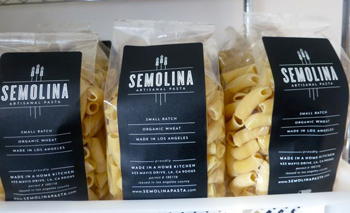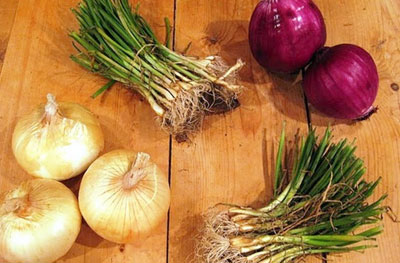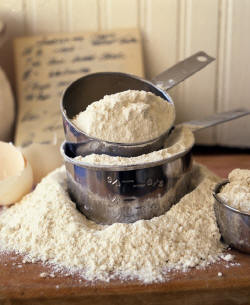 I’m a pasta snob. I admit it and I don’t apologize for it. I believe that great pasta is an Italian cultural artifact that’s been given to the world. And when I talk about pasta I’m talking about DRY PASTA, that is, Durum Wheat pasta. Pasta made with semolina from exceptional (now, often North American) hard winter wheat.
I’m a pasta snob. I admit it and I don’t apologize for it. I believe that great pasta is an Italian cultural artifact that’s been given to the world. And when I talk about pasta I’m talking about DRY PASTA, that is, Durum Wheat pasta. Pasta made with semolina from exceptional (now, often North American) hard winter wheat.
Over centuries Italian artisans learned how to combine hard wheat with water, humidity and moving air into an easy to store source of calories and whimsy. High quality dry pasta is all about texture.
When properly made it is porous enough to absorb condiments or “sauce”, yet sturdy enough to withstand boiling in water and remain resistant while tender. Good dry pasta should be as satisfying to eat as meat. It is not easy to achieve and my favorites are all imported from Italy.

 As in a good movie with scenes of tears, laughs, and tasteful delights, your venture with onions will boast the same sentiments. Vidalia, Spanish, yellow, white and red - onions can and should be your flavor backbones in the kitchen.
As in a good movie with scenes of tears, laughs, and tasteful delights, your venture with onions will boast the same sentiments. Vidalia, Spanish, yellow, white and red - onions can and should be your flavor backbones in the kitchen. For me, shopping isn't fun if I don't get a bargain. My grandmother
taught me well, "Never pay retail. If you want to be a good shopper,
you have to pay less than other people and still get as good." In our
neighborhood, Gelson's is the quality supermarket, carrying a full line of antibiotic-free, naturally raised meats. Which is great, except that they're pricey. The trick is to buy the meat when its been reduced, when a rib steak that was originally priced at $18.99/lb, is discounted to $7.99/lb. Any meat that's been reduced is still fresh, but it needs to be cooked that day
or frozen.
For me, shopping isn't fun if I don't get a bargain. My grandmother
taught me well, "Never pay retail. If you want to be a good shopper,
you have to pay less than other people and still get as good." In our
neighborhood, Gelson's is the quality supermarket, carrying a full line of antibiotic-free, naturally raised meats. Which is great, except that they're pricey. The trick is to buy the meat when its been reduced, when a rib steak that was originally priced at $18.99/lb, is discounted to $7.99/lb. Any meat that's been reduced is still fresh, but it needs to be cooked that day
or frozen. I remember so well my Mom making pancakes for us during the rather meagre times after World War 11. She would toss them up and often they would stick on the ceiling and we would find that so funny. There were always lots of eggs around as we would go to a nearby farm and get them and fresh milk and lots of herbs that me and my sisters would pick. We would lean over the side of the pig stys and watch with big eyes, what seemed like gigantic animals snorting in the mud! We ran after the chickens and were allowed into the coops to stick our fingers in and prise big brown eggs from under the nesting hens. Often the cock would frighten us off by screeching as we gathered the eggs!
I remember so well my Mom making pancakes for us during the rather meagre times after World War 11. She would toss them up and often they would stick on the ceiling and we would find that so funny. There were always lots of eggs around as we would go to a nearby farm and get them and fresh milk and lots of herbs that me and my sisters would pick. We would lean over the side of the pig stys and watch with big eyes, what seemed like gigantic animals snorting in the mud! We ran after the chickens and were allowed into the coops to stick our fingers in and prise big brown eggs from under the nesting hens. Often the cock would frighten us off by screeching as we gathered the eggs! I’m not really a baker. I make perfect oatmeal cookies (once every three years), perfect chocolate chip cookies (if really bored – Laraine Newman thinks the Joy of cooking recipe is the best, I just use the one on the back of the Nestle’s chocolate bits bag) The secret to chocolate chip cookies is fresh nuts, if you ask me, the quality of the pecans or the walnuts, changes the equation. Sometimes, if I’m feeling really wild, I’ll make butterscotch chip cookies, same recipe, but butterscotch bits instead of chocolate and totally delicious.
I’m not really a baker. I make perfect oatmeal cookies (once every three years), perfect chocolate chip cookies (if really bored – Laraine Newman thinks the Joy of cooking recipe is the best, I just use the one on the back of the Nestle’s chocolate bits bag) The secret to chocolate chip cookies is fresh nuts, if you ask me, the quality of the pecans or the walnuts, changes the equation. Sometimes, if I’m feeling really wild, I’ll make butterscotch chip cookies, same recipe, but butterscotch bits instead of chocolate and totally delicious.